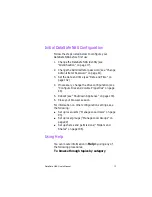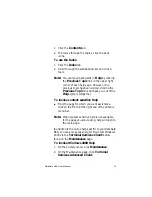
DataSafe NAS User’s Manual
16
2 Network Setup
From the
Network Setup
page, you can choose
which network-related properties of the DataSafe NAS
to configure:
n
Identification
—Set the name and domain
membership of the DataSafe NAS. (See
“Identification” on page 17.)
n
Interfaces
—Configure the local network settings
on the DataSafe NAS. (See “Interfaces: Network
Settings” on page 26.)
n
Global Settings
—Configure network settings
that apply to all network adapters on the DataSafe
NAS. (See “Global Settings: Network
Configuration” on page 34.)
n
Change Administrator Password
—Change
your password, or change the password of a user
who is also a member of the Administrators group
account. (See “Change Administrator Password”
on page 41.)
Note:
The second component of this task applies to
the user currently accessing the DataSafe
NAS, not to members of the “Administrator”
account.
n
SNMP Service Configuration
—Configure the
properties of the SNMP service on the DataSafe
NAS. This topic is covered in the Manage Services
chapter. (See “SNMP Service Configuration” on
page 90.)
n
NIC Configuration
—Configure the properties
of the NIC on the DataSafe NAS. (See “NIC
Configuration” on page 43.)
Summary of Contents for DataSafe Network Device
Page 1: ......
















































